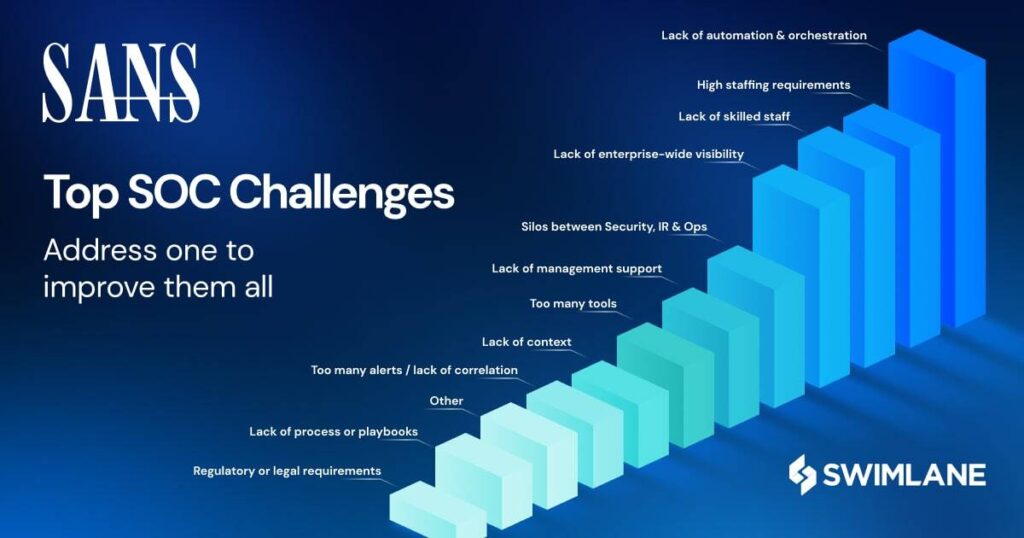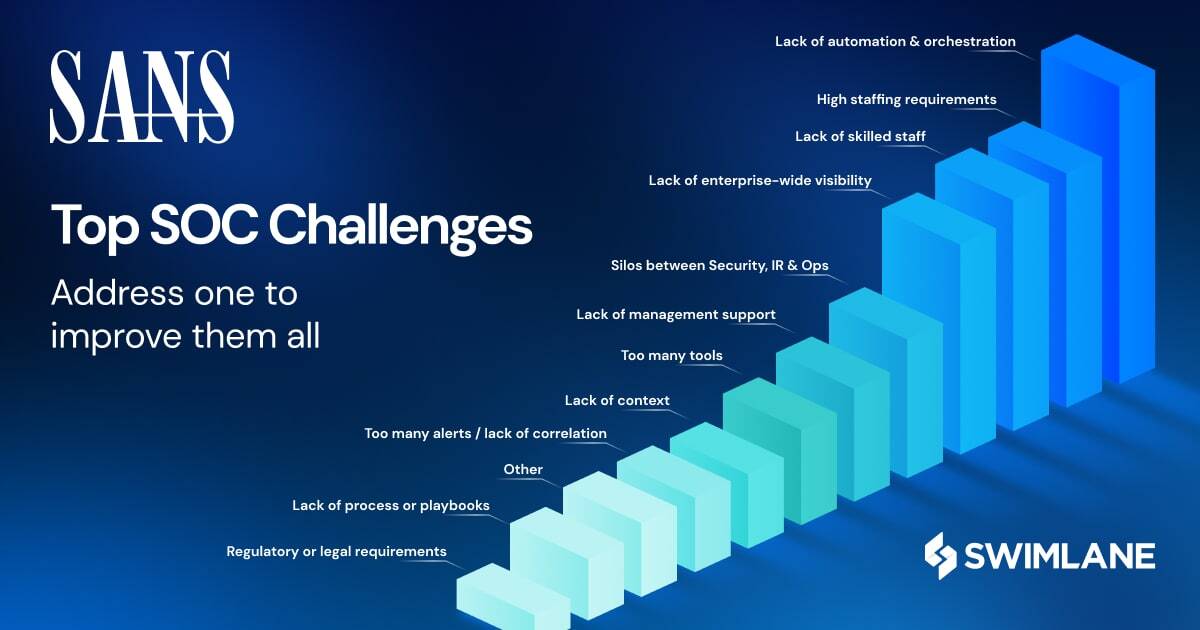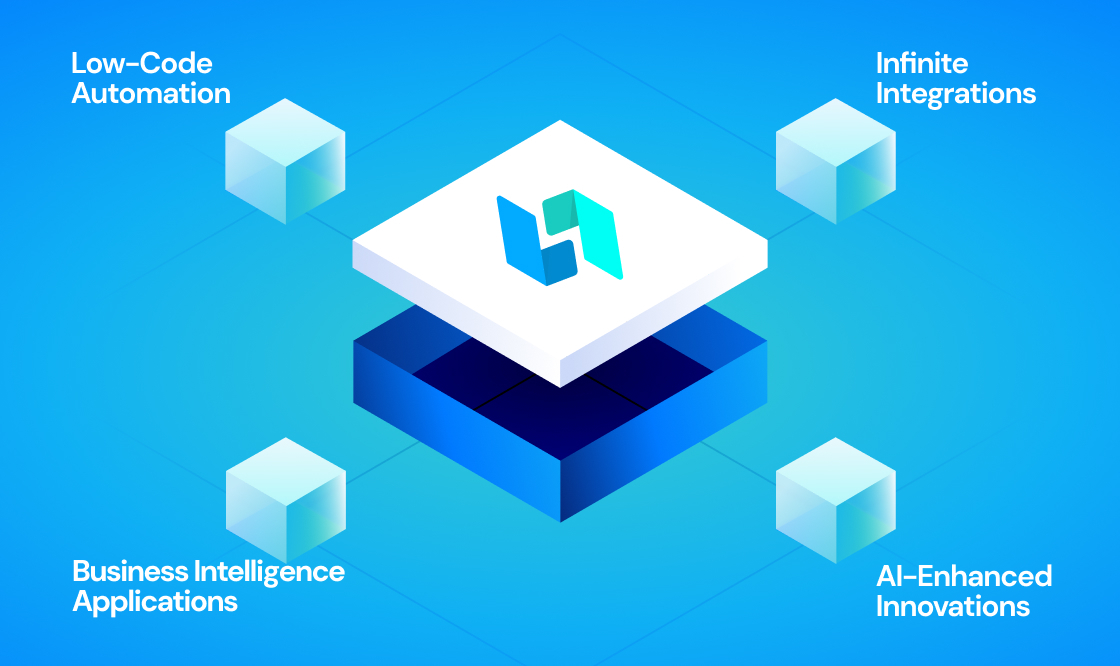Security Operations Centers (SOCs) are the frontline of defense against the myriad of threats facing organizations today. Building and sustaining an effective SOC encompasses a blend of art and science, presenting a complex challenge for many. According to the 2024 SANS Security Operations Center Survey, lack of automation and orchestration was the top barrier for effective SOC management.

At Swimlane, we pride ourselves on being pioneers in automating SOC processes, consistently offering innovative and transformative solutions. We’re excited to share how our unique solutions and approaches are making a significant impact on SOC management, so let’s get into it.
How To Manage a Security Operations Center (SOC)
With proven business outcomes and ROI from Swimlane customers, it’s evident that selecting the right solution and striving for excellence in security automation are vital for achieving efficient SOC management. Remember, organizations should #NeverSettle for “good enough” security automation.
Continue reading to discover the key elements crucial for successful SOC management.
1. Define Your Objectives
Clearly defining your SOC’s objectives in monitoring, detection, response, and prevention is crucial for effective management. Equally important is demonstrating progress and ROI to leadership. Security automation helps by providing clear security metrics that show how time and costs are saved, proving the value of your SOC investments.
2. Assemble the Right Team
As mentioned previously, your SecOps efficacy is heavily reliant on the strength of its team. Ensure you have a diverse group of professionals with expertise in incident response and threat analysis. Additionally, with the exponential growth of Artificial Intelligence (AI) in cybersecurity your team should include some members specialized in this area. Regardless of SOC team size, security professionals are crucial for effective SecOps and incident response. Both small and large teams benefit from additional technology support like AI, in managing the thousands of daily alerts. Continuous training and skills development are also key to keeping your team sharp and up-to-date.
3. Establish Clear Roles and Responsibilities
Define the roles within the SOC, such as SOC manager, analysts, and engineers. Given the specialized nature of cybersecurity tasks, each team member needs to have a precise understanding of their role, whether it’s monitoring and identifying security breaches, managing incident response, or conducting forensic analysis on past attacks. This clarity not only enhances the team’s ability to respond swiftly to threats but also fosters a culture of accountability and continuous improvement within the cybersecurity framework.
4. Choose the Right SOC Vendor and Solutions
Partnering with the right SOC vendor is critical to comprehensive SOC management. Look for vendors that offer comprehensive solutions tailored to your specific needs. As mentioned, we here at Swimlane provide robust low-code automation platforms that can significantly enhance your SOC’s efficiency by automating repetitive tasks and streamlining processes.
5. Outline Your SOC Management Process
Every SOC is unique, with its own set of protocols and strategies for handling security incidents. This means that managing a SOC involves a tailored approach, carefully designed to meet the specific needs and challenges of the organization it protects. No matter what, your SOC management process should include identifying potential security threats, monitoring network activity for suspicious behavior, responding timely to detected incidents, and continuously improving security measures based on lessons learned and evolving threats.
6. Leverage Threat Intelligence
Stay ahead of threats by incorporating real-time threat intelligence into your security operations. This will help you understand the tactics, techniques, and procedures (TTPs) of adversaries, allowing for proactive defense measures.
7. Focus on Continuous Improvement
Given the dynamic nature of the threat landscape, we have to be sure our SOC is evolving alongside it. This involves regularly reviewing and updating SOC best practices. Like security policies, procedures, and technology stacks as well as conducting frequent training simulations. Aligning security operations with business goals is essential for ensuring that security efforts support overall success and stability.
8. Prioritize Incident Response, Remediation, and Recovery
Develop and maintain a comprehensive incident response plan. Ensure it’s well-documented, accessible, and easy to comprehend for all team members and C-suite executives. Practice regular drills and adjust the plan based on lessons learned from real incidents and simulations.
9. Monitor and Measure SOC Performance
Establish key performance indicators (KPIs) to measure the effectiveness of your SOC. Security metrics might include MTTD and MTTR, as well as user satisfaction and the overall resilience of your IT environment. Efficient reporting is crucial here
10. Encourage a Culture of Security Awareness
Finally, it’s important to recognize that security, while primarily reliant on SecOps, is a shared responsibility across the organization. Promoting a company-wide culture of security awareness through consistent training and updates on security best practices for all employees can significantly reduce the risk of breaches and attacks.
4 Ways Swimlane Turbine Helps with Managing Security Operations
It’s essential that SOC teams have robust tools to manage and optimize their security operations effectively. Swimlane Turbine offers a range of features designed to enhance efficiency and streamline processes.
Here are four key ways Turbine transforms SOC management and elevates SecOps performance:
1. Simplify Automation with Low-Code Automation Playbook Building Studio
With Turbine Canvas, SOC teams are empowered with a low-code security automation playbook building studio that simplifies automation and offers extensive customization and flexibility. Turbine Canvas allows teams to create tailored automation solutions through their choice of no-code drag-and-drop actions or by writing their own Python scripts. Turbine’s high-performance automation engine enables SOC teams to execute over 25 million actions daily per customer, triaging alerts, cases or incidents at unprecedented speed.
2. Streamline Workflows and Improve Cross-Functional Collaboration with Business Intelligence Applications
Business intelligence applications like case management, highly composable dashboards, and AI-enhanced reporting establish a system of record to help security teams streamline workflows in and beyond the SOC. Effective case management is crucial for SOC teams to streamline workflows, centralize tracking incidents, and enhance team collaboration. Swimlane Turbine excels in this area with its extensive functionality, offering over 72 record fields, AI-enhanced case summarization, and recommended actions. Turbine’s self-documenting dashboards and reports deliver actionable insights on security KPIs, compliance, and team performance, enabling SOC teams to customize their case management and improve cross-functional collaboration.
3. Boost Productivity with AI-Enhanced Innovations
For SOC teams, leveraging advanced AI technology enhances operational efficiency and effectiveness. With Turbine’s Hero AI, a suite of AI-enhanced innovations, SOC teams are enabled to boost operational efficiency through crafted AI prompts, case summarization, recommended actions, AI-augmented reporting, and the generation of intricate Python code, all while ensuring the utmost privacy and security of an organization’s data. Hero AI’s capabilities automate complex tasks and deliver actionable insights, significantly improving security operations.
4. Optimize Security Operations with Infinite Integrations
Seamless integration is imperative for optimizing security operations. Swimlane offers infinite integrations within Swimlane Marketplace, the first full-stack modular marketplace for security automation. With a vast library of connectors, no-code playbook building components, dashboard widgets, and pre-built solutions, it’s easier than ever to get started with SOC automation. But what is SOC Automation? The Swimlane SOC Automation Solution, also available in Marketplace, incorporates industry best practices for automating phishing, SIEM alert triage, threat intelligence, and case management, and can be implemented in under two weeks.
Choose Swimlane for Managing Security Operations
In today’s crowded security market, selecting the right solutions is crucial. Modern SOC teams should never settle for merely “good enough” security automation. The ideal solutions not only protect organizations but also empower SOC analysts and deliver significant value. Whether your SOC team is small or large, they play a critical role in maintaining efficient SecOps and incident response. Adopting a solution like Swimlane Turbine, the triple threat of automation, GenAI, and low-code that solves the most challenging problems across the entire security organization is a step towards SOC management efficiency. Join us in laying a resilient foundation for your organization’s SOC management.

SANS Security Operations Center Survey
Security Operations Centers (SOC) continue to evolve and mature their capabilities, architectures, and management strategies as the threat landscape evolves. The 2024 SANS SOC Survey, written by Chris Crowley, analyzes data from global SOC teams to report on common challenges and how leaders intend to recalibrate near and long-term plans.


